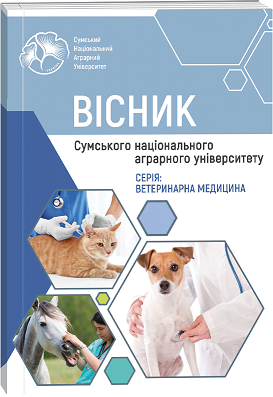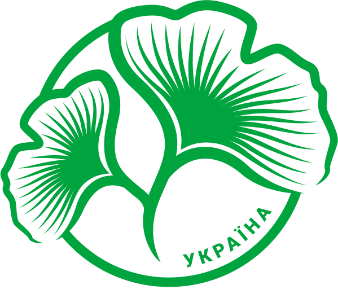ЛЕПТОСПІРОЗ СІЛЬСЬКОГОСПОДАРСЬКИХ ТВАРИН НА ТЕРИТОРІЇ СУМСЬКОЇ ОБЛАСТІ
Анотація
Лептоспіроз є небезпечним зоонозним захворюванням, моніторинг якого необхідний не тільки для стабільної діяльності сільськогосподарських підприємств, а і для забезпечення здоров’я людей. Метою даної роботи було провести аналіз моніторингових досліджень на території Сумської області за період 2021–2024 рр. та врахувати фактори, які можуть впливати на результати проведеного моніторингу та інтенсивність поширення хвороби. В результаті проведеного аналізу встановили, що епізоотична ситуація демонструє позитивну динаміку, яка виражається у зниженні рівня захворюваності серед досліджуваних сільськогосподарських тварин. Серед овець та кіз лептоспірозу протягом чотирьох років виявлено не було, однак у досліджуваної великої рогатої худоби рівень захворюваності на початку аналізованого періоду становив 19,5%, поступово знижуючись до 9% станом на жовтень 2024 року. Серед свиней також спостерігається позитивна динаміка, хоча у 2023 році було зафіксоване збільшення кількості хворих тварин на 50% у порівнянні з показниками за 2022 рік. Відсоток позитивно реагуючих голів серед досліджуваних коней зазнав значних коливань, знизившись до 1,6% у 2022 році та тримаючись на рівні 9%–11% останні два роки. Наступним етапом була оцінка зміни об’єму поголів’я сільськогосподарських тварин на території Сумської області, так як кількість сприйнятливих тварин безпосередньо впливає на інтенсивність поширення захворювання. В результаті аналізу звітності Державної служби статистики України виявили, що поліпшення ситуації може бути частково пов'язане зі значним скороченням поголів'я сільськогосподарських тварин та зменшенням охоплення моніторингу, що може давати хибні уявлення про епізоотичну картину. Також особливу увагу приділили аналізу чинників, що потенційно впливають на поширення лептоспірозу в умовах воєнних дій та можуть спричинити погіршення епізоотичної ситуації в регіоні. Серед основних факторів ризику виділили забруднення водойм, зростання популяції гризунів і соціально-економічні зміни. На 2024 рік Сумська область залишається неблагополучною щодо лептоспірозу, що свідчить про необхідність постійного моніторингу захворювання серед сільськогосподарських та домашніх тварин, посилення профілактичних заходів, контролю за санітарним станом водойм та своєчасного проведення дератизації.
Посилання
2. Calderón, A., Rodríguez, V., Máttar, S., & Arrieta, G. (2014). Leptospirosis in pigs, dogs, rodents, humans, and water in an area of the Colombian tropics. Tropical animal health and production, 46(2), 427–432. https://doi.org/10.1007/s11250-013-0508-y
3. Di Azevedo, M. I. N., & Lilenbaum, W. (2021). An overview on the molecular diagnosis of animal leptospirosis. Letters in applied microbiology, 72(5), 496–508. https://doi.org/10.1111/lam.13442
4. Díaz, E. A., Arroyo, G., Sáenz, C., Mena, L., & Barragán, V. (2023). Leptospirosis in horses: Sentinels for a neglected zoonosis? A systematic review. Veterinary world, 16(10), 2110–2119. https://doi.org/10.14202/vetworld.2023.2110-2119
5. Dubey, S., Singh, R., Gupta, B., Patel, R.P., Soni, D., Dhakad, B.K., Reddy, B.M., Gupta, S., & Sharma, N. (2021). Leptospira: An emerging zoonotic pathogen of climate change, global warming and unplanned urbanization: A review. Journal of Entomology and Zoology Studies 9.1, pp. 564–571.
6. Ellis W. A. (2015). Animal leptospirosis. Current topics in microbiology and immunology, 387, 99–137. https://doi.org/10.1007/978-3-662-45059-8_6
7. Flay, K. J., Yang, D. A., Wilson, M. T., Lee, S. H., Bhardwaj, V., Hill, F. I., & Pfeiffer, D. U. (2021). Absence of serological or molecular evidence of Leptospira infection in farmed swine in the Hong Kong Special Administrative Region. One health (Amsterdam, Netherlands), 13, 100321. https://doi.org/10.1016/j.onehlt.2021.100321
8. Flores, B., Escobar, K., Muzquiz, J. L., Sheleby-Elías, J., Mora, B., Roque, E., Torres, D., Chávez, Á., & Jirón, W. (2020). Detection of Pathogenic Leptospires in Water and Soil in Areas Endemic to Leptospirosis in Nicaragua. Tropical medicine and infectious disease, 5(3), 149. https://doi.org/10.3390/tropicalmed5030149
9. Goarant C, Trueba G, Bierque E, Thibeaux R, Davis B, De la Peña Moctezuma (2019). Leptospira and leptospirosis. In: Rose JB, JiménezCisneros B, editors. Water and sanitation for the 21st century: health and microbiological aspects of excreta and wastewater management (Global Water Pathogen Project). (Pruden A, Ashbolt N, Miller J, editors. Part 3: Bacteria.) East Lansing, Michigan: Michigan State University Press, UNESCO.
10. Goris, M. G., & Hartskeerl, R. A. (2014). Leptospirosis serodiagnosis by the microscopic agglutination test. Current protocols in microbiology, 32, . https://doi.org/10.1002/9780471729259.mc12e05s32
11. Hamond, C., Pinna, A., Martins, G., & Lilenbaum, W. (2014). The role of leptospirosis in reproductive disorders in horses. Tropical animal health and production, 46(1), 1–10. https://doi.org/10.1007/s11250-013-0459-3
12. Kamath, R., Swain, S., Pattanshetty, S., & Nair, N. S. (2014). Studying risk factors associated with human leptospirosis. Journal of global infectious diseases, 6(1), 3–9. https://doi.org/10.4103/0974-777X.127941
13. Kambur, M. D., Livoshchenko, L. P., Livoshchenko, Ye. M. (2009). Epizootolohichnyi monitorinh leptospirozu u silskohospodarskykh tvaryn u Sumskii oblasti [Epizootic monitoring of leptospirosis in farm animals in the Sumy region]. Veterynarna medytsyna [Veterinary medicine]. Vol. 92, pp. 222–226. (in Ukrainian)
14. Lau, C. L., Smythe, L. D., Craig, S. B., & Weinstein, P. (2010). Climate change, flooding, urbanisation and leptospirosis: fuelling the fire?. Transactions of the Royal Society of Tropical Medicine and Hygiene, 104(10), 631–638. https://doi.org/10.1016/j.trstmh.2010.07.002
15. Leshem, E., Segal, G., Barnea, A., Yitzhaki, S., Ostfeld, I., Pitlik, S., & Schwartz, E. (2010). Travel-related leptospirosis in Israel: a nationwide study. The American journal of tropical medicine and hygiene, 82(3), 459–463. https://doi.org/10.4269/ajtmh.2010.09-0239
16. Levett P. N. (2001). Leptospirosis. Clinical microbiology reviews, 14(2), 296–326. https://doi.org/10.1128/CMR.14.2.296-326.2001
17. Loureiro, A. P., & Lilenbaum, W. (2020). Genital bovine leptospirosis: A new look for an old disease. Theriogenology, 141, 41–47. https://doi.org/10.1016/j.theriogenology.2019.09.011
18. Miotto, B. A., Tozzi, B. F., Penteado, M. S., Guilloux, A. G. A., Moreno, L. Z., Heinemann, M. B., Moreno, A. M., Lilenbaum, W., & Hagiwara, M. K. (2018). Diagnosis of acute canine leptospirosis using multiple laboratory tests and characterization of the isolated strains. BMC veterinary research, 14(1), 222. https://doi.org/10.1186/s12917-018-1547-4
19. Monahan, A. M., Miller, I. S., & Nally, J. E. (2009). Leptospirosis: risks during recreational activities. Journal of applied microbiology, 107(3), 707–716. https://doi.org/10.1111/j.1365-2672.2009.04220.x
20. Ospina-Pinto, C., Rincón-Pardo, M., Soler-Tovar, D., & Hernández-Rodríguez, P. (2017). Papel de los roedores en la transmisión de Leptospira spp. en granjas porcinas [The role of rodents in the transmission of Leptospira spp. in swine farms]. Revista de salud publica (Bogota, Colombia), 19(4), 555–561. https://doi.org/10.15446/rsap.v19n4.41626
21. Pyskun, A., Ukhovskyi, V., Pyskun, O., Nedosekov, V., Kovalenko, V., Nychyk, S., Sytiuk, M., & Iwaniak, W. (2019). Presence of Antibodies Against Leptospira interrogans Serovar hardjo in Serum Samples from Cattle in Ukraine. Polish journal of microbiology, 68(3), 295–302. https://doi.org/10.33073/pjm-2019-031
22. Ramos, A. C., Souza, G. N., & Lilenbaum, W. (2006). Influence of leptospirosis on reproductive performance of sows in Brazil. Theriogenology, 66(4), 1021–1025. https://doi.org/10.1016/j.theriogenology.2005.08.028
23. Salgado, M., Otto, B., Moroni, M., Sandoval, E., Reinhardt, G., Boqvist, S., Encina, C., & Muñoz-Zanzi, C. (2015). Isolation of Leptospira interrogans serovar Hardjoprajitno from a calf with clinical leptospirosis in Chile. BMC veterinary research, 11, 66. https://doi.org/10.1186/s12917-015-0369-x
24. Schneider, M. C., Jancloes, M., Buss, D. F., Aldighieri, S., Bertherat, E., Najera, P., Galan, D. I., Durski, K., & Espinal, M. A. (2013). Leptospirosis: A Silent Epidemic Disease. International Journal of Environmental Research and Public Health, 10(12), 7229-7234. https://doi.org/10.3390/ijerph10127229
25. Smith, C. R., Ketterer, P. J., McGowan, M. R., & Corney, B. G. (1994). A review of laboratory techniques and their use in the diagnosis of Leptospira interrogans serovar hardjo infection in cattle. Australian veterinary journal, 71(9), 290–294. https://doi.org/10.1111/j.1751-0813.1994.tb03447.x
26. Sohm, C., Steiner, J., Jöbstl, J., Wittek, T., Firth, C., Steinparzer, R., & Desvars-Larrive, A. (2023). A systematic review on leptospirosis in cattle: A European perspective. One health (Amsterdam, Netherlands), 17, 100608. https://doi.org/10.1016/j.onehlt.2023.100608
27. Tansakul, M., Sawangjai, P., Bunsupawong, P., Ketkan, O., Thongdee, M., Chaichoen, K., & Sakcamduang, W. (2024). Survival outcomes, low awareness, and the challenge of neglected leptospirosis in dogs. Open veterinary journal, 14(9), 2368–2380. https://doi.org/10.5455/OVJ.2024.v14.i9.25
28. Turchenko O.N., Zon G.A. (2018) Leptospirosis in dogs in Sumy: epizootic monitoring, diagnostics and treatment [Leptospiroz sobak u m. Sumy: epizootychnyi monitorynh, diahnostyka ta likuvannia] Veterinary biotechnology, Vol. 32, pp.545–550 (in Ukrainian) https://doi.org/10.31073/vet_biotech32(2)-66
29. Zon G.A., Ivanovskaya L.B. (2018) Suchasna epizootychna kartyna shchodo leptospirozu velykoi rohatoi khudoby v Sumskii oblasti [Current epizootic state on leptospirosis of cattle in Sumy oblast] Veterinary biotechnology, Vol. 32, pp.193–201(in Ukrainian) https://doi.org/10.31073/vet_biotech32(2)-22
30. Zubach, O., Pestushko, I., Dliaboha, Y., Semenyshyn, O., & Zinchuk, A. (2023). A Single Clinical Case of Leptospirosis in a 70-Year-Old Man During the Military Conflict in Ukraine. Vector borne and zoonotic diseases (Larchmont, N.Y.), 23(7), 384–389. https://doi.org/10.1089/vbz.2023.0007

 ISSN
ISSN  ISSN
ISSN 



